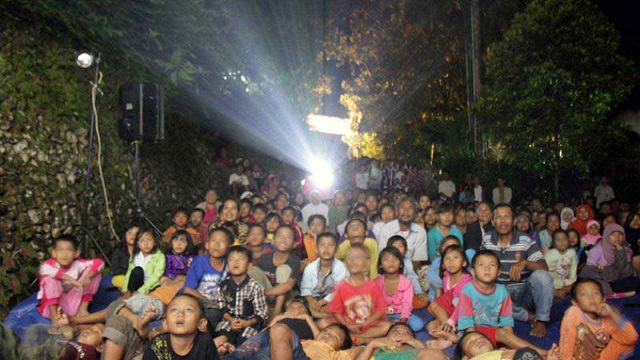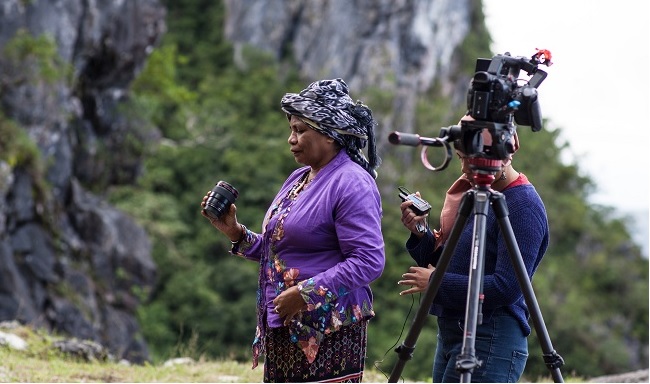The production of visual content has exploded in recent years. Increasingly this medium is being used in innovative ways to tell stories and encourage action on political and social issues
Edwin Jurriëns & Jemma Purdey
One of the commonly acknowledged achievements of the post-1998 process of democratic reform or reformasi in Indonesia has been the increased freedom of expression including media freedom. Significant milestones have included the abolition of the notorious Ministry of Information (Departemen Penerangan) feared for its censorship practices, the ending of the intricate licensing procedures for print publications and the legalisation of news production by commercial radio and television, the official recognition of community media as a category in its own right.
The post-New Order period has also seen the emergence of new threats to freedom of speech. Instead of a genuine decentralisation of the media in line with the political ideal of regional autonomy, national players have usurped regional media businesses and successful local players have expanded their businesses to other regions. Large media companies have been used to give shape to the political ambitions of their owners. To protect themselves against the ongoing threats of lawsuits by powerful individuals and thuggery by militant groups in society, journalists have in fact continued practices of self-censorship known from the pre-reformasi period.

At the same time, there has been an explosion of what Thomas Barker in this edition calls ‘new media making’, whereby individuals and groups in society have used a variety of creative media, including visual media, and strategies to oppose or circumvent these limitations to freedom of expression, and to try and safeguard diversity, activism and other prime democratic values in contemporary Indonesia.
This edition of Inside Indonesia focuses on a burgeoning independent screen culture, which ranges from arthouse cinema to YouTube and streaming platforms, and includes narrative fiction and documentary production. Our contributors investigate the ways in which those who produce and disseminate visual content – be it for cinematic release or online - are employing the screen to tell stories and encourage action on political and social issues of increasing importance to Indonesians. Such issues include gender equity and representations of women and sexual minorities, representations of alternative versions of Indonesia's human rights record and history, and environmental activism.
Where has this ‘movement’ come from? How can it be sustained and negotiated in a crowded media-scape that is in many ways increasingly hostile to opposition or resistant voices?
Politics on screen
The edition opens with an article by David Hanan looking back to the past to ask ‘was there “filmic activism” during the Sukarno and Suharto periods?’ during which democracy was tenuous at best or did not exist at all. Within a highly censored and commercialised fledgling national film industry, Hanan reveals the modes of resistance and protest adopted by filmmakers, which included the expert use of allegory and subversive satire. As he points out, whilst activism in filmmaking has become more prominent in post-New Order Indonesia, it was indeed, always there.
Articles by Galuh Wandita & Aghniadi, and Edwin Jurriëns and an interview with documentary filmmaker Kartika Pratiwi, highlight the work of contemporary filmmaker activists. Wandita and Aghiadi belong to the organisation AJAR (Asia Justice and Rights) and are producers of its various documentary projects focused on human rights issues in Indonesia, Timor Leste and Myanmar. The element of survivor-led storytelling is the particular focus of their work and the films serve numerous purposes, including forging a sense of solidarity amongst those involved and society broadly; education about human rights; and recording and re-contextualising the narrative about historical human rights abuses. Jurriëns examines a series of documentary films focused on struggles involving environmental activists in Indonesia, all of which highlight the central roles of female protagonists in the movement. And Jemma Purdey's interview with filmmaker activist Kartika Pratiwi offers insight into how a generation of Indonesians who have grown up in post-New Order Indonesia, are asking questions about the past and finding innovative and creative ways for reaching audiences.
Distribution for impact
Since the 1990s, Indonesian filmmakers whose work includes controversial or oppositional themes have looked to international festivals as a critical part of their distribution strategy. Whilst initially used by those like Garin Nugroho who were seeking to evade the New Order at the time, as Thomas Barker points out, the increased internationalisation of Indonesia's film industry through festivals and more recently deterritorialised online streaming platforms, perform an important role economically, but also in support of cultural democracy.

Egbert Wits draws on his experience working with EngageMedia, an organisation that promotes digital rights and social issue documentary in the Asia-Pacific. He provides an assessment of the potential for content like that being produced by AJAR, Pratiwi and many other activist filmmakers to make the kind of change they are hoping for. Wits argues it is time for Indonesian filmmakers to move beyond the ‘traditional’ focus on international festivals to create momentum around the issues raised in their films. For domestic political purposes there is much to indicate that adopting Film Impact Production strategy early in the production schedule will greatly enhance the outcomes for filmmakers of such work, and also help them to better understand and deal with the risks involved in tackling often sensitive political and social issues.
Cultural activism
The final article in the edition turns the focus to Indonesia’s film industry itself and a culture that has failed to provide a workplace that is safe, equal and inclusive for all individuals regardless of their identity. The #MeToo movement that began in Hollywood over five years ago, sent shock waves and it is hoped, brought real change within film communities around the world. The article’s authors – all film scholars and educators – are part of a consortium of educators and film people taking active steps to first understand the problems and challenges around gender equity and social inclusion (GESI) in the local film industry, and to provide their colleagues with tools to implement GESI principles and protocols in their curricula and institutions. As the authors know very well, these challenges track deep into society itself.
The development and internationalisation of Indonesia’s film industry is bringing with it greater levels of professionalism and institutionalisation. Alongside what some have labelled a democratisation of filmmaking with the digital technology boom, this has seen growth in opportunities for young Indonesians to study the craft of filmmaking at tertiary and even high school level, but also the emergence of self-taught filmmakers engaging online platforms to distribute their work. For filmmakers seeking to encourage action on political and social issues in Indonesia and beyond, there are many signs that the future holds great potential. Although challenges remain for activism of all forms in Indonesia, like those who came before them in the 1950s-1990s, activist filmmakers in Indonesia work within a culture that breeds and thrives on creativity, innovation and agility, and which ultimately brings their work to their audiences’ screens, one way or another.
Edwin Jurriëns is Convenor of Indonesian Studies at the Asia Institute, The University of Melbourne. Jemma Purdey is Commissioning Editor of Inside Indonesia and director of the ReelOzInd! Australia Indonesia Short Film Festival.
This edition has been supported by two University of Melbourne Hallmark Research Initiatives: ‘Indonesia Democracy’ (IDeHaRI) from the Centre of Indonesian Law, Islam and Society, and ‘Creativity and Wellbeing’ from the School of Culture and Communication, the Research Unit in Enlightenment, Romanticism, and Contemporary Culture, the Asia Institute, and the Victorian College of the Arts.












